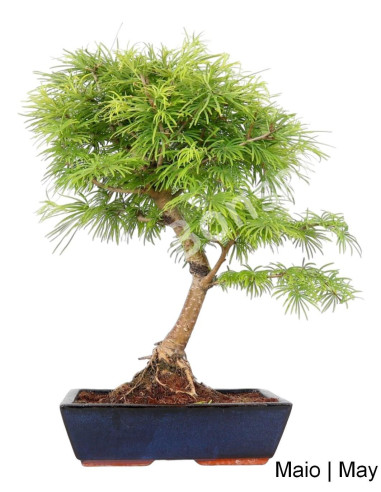- -10%
Pseudolarix Bonsai 17 years
Species belonging to the family of Pinaceaes and from China.
It is a small tree that has as special speciality to be a caduca conifer, the needles yellow in winter and fall completely.
Its bark also has a special beauty, being of a gray tone and going to open grits over the years.
Pseudolarix Bonsai is an outdoor plant.
Common Name: Pseudolarix
Scientific name: Pseudolarix Amabilis
Characterization: Member of the family of Pináceaes, is from China.
Small-sized tree, it has as special speciality to be a caduca conifer, the needles yellow in winter and fall completely.
Its bark also has a special beauty, being of a gray tone, and going to open grits over the years.
Location: Outside, well exposed to the sun where take 2 to 3 hours of direct sun per day (ideal in the morning or at the end of the day), protected from strong winds and frosts.
At the peak of summer it should be protected from the sun in the strongest hours (a shade mesh is usually enough) to avoid burning the new needles.
Water: To water abundantly the earth until a lot of water goes out through the drain holes in order to moisten evenly the soil, always above never by immersion, with a fine drain waterer.
Tips on watering, see technical data collection.
Let dry the surface layer of the soil between each watering (to confirm if the plant already needs water, touch the earth with the fingers). It consumes water moderately, even if we should have special attention in summer, because with thirst new needles dry quickly.
If you have a dish under Bonsai, never leave any water in it (to prevent the roots from rotting).
There is no advantage in spraying the leaves, just do it in days that it adds and if the fertilizer is specific for foliar application, but ensure that they arrive dry at night to avoid fungi.
Nutrition: From February to September, with a base plan composed of a complete fertilizer (Fertil Bonsai Humic, or Green & Gold Bonsai Organic or Biogold), and a biostimulant (Bio Bonsai Activ), can still be linked with other products in our range.
Detailed information on how to combine these products the rest of our range, or for a more specific nutrition plan, see complete nutrition plan technical sheet.
Poda: The formation pruning can be made at the end of winter when it is without leaves. The maintenance pruning is made by cutting on top of a new gum, which are easily identified together to the new needles.
Tips on pruning, see the technical sheet pruning and defoliation.
Transplantation: With Terra Bonsai Coníferas in February/March, when the gomos begin to "move".
Details about transplants, post transplants and specific fortifiers that you can use refer to repotting technical sheet.
Pluming: At the end of the winter before the sprouting.
Indications on padding, see wiring technical sheet.
- Habitat
- Outdoor
- Sheet Type
- Deciduous
- Species
- Pseudolarix
- Origin
- China


































